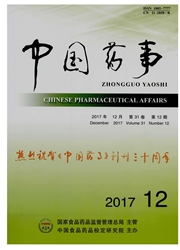

 中文摘要:
中文摘要:
目的:评价新医改实施第二阶段基层医疗机构合理用药指标及处方行为改善情况,为医改实施效果评估提供参考。方法:在四川省内选取13家乡镇卫生院、7家社区卫生服务中心基层医疗卫生机构,抽取2013-2015年1、4月门诊处方共3397张,采用世界卫生组织(WHO)合理用药调研方法与指标进行分析评价。结果:20家基层医疗卫生机构在2013、2014、2015年的处方平均费用(元)分别为27.81、31.20、34.93,呈逐年增加趋势,低于参考标准;平均处方药品数分别为2.998、3.102、3.035,高于参考标准;通用名使用率分别为99.46%、98.18%、99.53%,低于参考标准;处方基本药物比例分别为90.63%、94.49%、94.84%,低于参考标准;抗菌药物处方率分别为49.76%、48.18%、46.80%,呈逐年下降趋势,但仍高于参考标准;注射剂处方率分别为17.31%、25.00%、17.34%,基本符合参考标准,但社区卫生服务中心高于乡镇卫生院;激素处方率分别为9.555%、9.635%、10.10%,基本符合参考标准,但乡镇卫生院高于社区卫生服务中心。结论:新医改实施后基层医疗机构合理用药水平有所提高,但仍然存在不合理和不规范行为,需采取措施加强监管。
 英文摘要:
英文摘要:
Objective: To evaluate indicators of rational drug use and improvement of prescribing practice in primary health care institutions during the second stage of the new national medical reform, so as to provide references for evaluating the effect of implementation of the national medical reform. Methods: A total of 3397 outpatient prescriptions from 7 community health care centers and 13 town health care institutions in Sichuan Province in January and April from 2013 to 2015 were analyzed by using the World Health Organization(WHO) rational drug use survey methods and indicators. Results: The average cost of prescriptions of the 20 primary health care institutions in 2013, 2014 and 2015 was 27.81, 31.20 and 34.93 respectively, which showed an increasing trend year by year and was lower than that of the standard; the average number of drugs of prescriptions was 2.998, 3.102 and 3.035 respectively, which was higher than that of the standard; percentage of drugs prescribed by generic name was 99.46%, 98.18% and 99.53% respectively, which was lower than that of the standard; percentage of drugs prescribed from essential drug list was 90.63%, 94.49% and 94.84% respectively, which was lower than that of the standard; percentage of prescriptions with antibiotics prescribed was 49.76%, 48.18% and 46.80% respectively, which showed an decreasing trend year by year and was higher than that of the standard; percentage of prescriptions with an injection prescribed was 17.31%, 25.00% and 17.34% respectively, which met the standard in general and the results in community health care centers were higher than those in town health care institutions; percentage of prescriptions with a glucocorticoid prescribed was 9.555%, 9.635% and 10.10% respectively, which met the standard in general and the results in town health care institutions were higher than those in community health care centers. Conclusion: The rational drug use practice has been improved in primary health care institutions after the implementation of the new
 同期刊论文项目
同期刊论文项目
 同项目期刊论文
同项目期刊论文
 期刊信息
期刊信息
